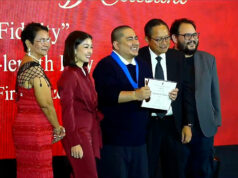By Noel Vera
Movie Review
10 Cloverfield Lane
Directed by Dan Trachtenberg
HOW GOOD is the first three-fourths of Dan Trachtenberg’s supposed sequel to Matt Reeves’s popular monster movie (Cloverfield)? Let me put it this way: it makes one bitterly regret staying for the film’s last fourth; it makes one forget the fitful cleverness of the first picture; and it makes one reject the redemptive tone of Lenny Abrahamson’s more conventionally dramatic film of similar premise, screened in American theaters last year (Room).
From intense breakup to traumatic car crash to reassuring IV needle to less-than-comforting ankle iron, Michelle (the fetchingly limber Mary Elizabeth Winstead) almost wordlessly gives us background and premise to her character, with indications as to her future prospects (not good). Decreasing her prospects drastically with his appearance alone is Howard (John Goodman, looking as if he’d killed and buried Rosanne Barr in that same floor over a decade back). He sports a week-old stubble and has apparently failed to bathe for at least as long; he does a poor job of calming Michelle down, urging her to do her business as if they had been at this for months if not years (the fetters don’t help; they’re leather-and-stainless-steel shackles — far more elaborate than anything I’ve seen at work — and designed to avoid creating sores… meaning you can keep them on your captive for some time if you have to).
Howard’s mysterious companion Emmett (John Gallagher, Jr.) is younger and comparatively more appealing, though I wouldn’t want to guess at the state of his body hygiene.
Two and one make three, living in uneasy harmony. Emmett and Michelle are tense around Howard, who’s given to near-incoherent ramblings when he’s not giving in to fits of bellowing temper (like George Wendt in Stuart Gordon’s King of the Ants, Goodman seems happy to trade in his amiable TV persona for one altogether more threatening, that doesn’t hesitate to use its bulk to cow others into submission. The familiar turned frightening freaks us out; the actor knows this and uses it accordingly). The scenes of domestic tranquility — the meals, the parlor games, the memorably uncomfortable moment Howard introduces Michelle to their one and only shower room — are hilarious parodies of the classic American household, partly because their roles are so fluid (Howard is both patriarch and ardent suitor; Emmett an overstaying slacker child and furtive paramour; Michelle both placating mother and panicky maiden), partly because Howard so visibly yearns for the perfect family — just him and Michelle, preferably, without Emmett hanging about.
Perhaps what makes Howard so disturbing isn’t the fact that he’s nuts but that he has moments here and there when he’s personable, even charming. The endless monologues detailing precautions he’s taken, the endless sacrifices he’s made for his two guests, are endlessly funny — they suggest a sense of entitlement a mile wide — but once or twice the monologue veers into pathos, and you find yourself feeling unexpectedly awkward. You find yourself — despite circumstances and your repulsion, despite the hairs rising like iron filings up the back of your neck — identifying with him (there but for the grace of God).
Goodman’s Howard makes the film but Winstead’s Michelle is the wary intelligence that speak on our behalf. Winstead concedes generously to Goodman’s outsized presence, underlines his outer-space worldview with her more common sense; Gallagher’s Emmett is strangely appealing — you suspect he’s as crazy (why shack up with such an obvious whacko?), butsense a humanity within that you root for anyway.
The idea for the film came from a script by John Campbell and Matt Stuecken called The Cellar, with additional rewrites by Damien Chazelle; its roots can be traced back to subterranean science-fiction films like LQ Jones’ A Boy and His Dog, and George Romero’s Day of the Dead. Another possible antecedent: Philip K. Dick’s classic short story “The Defenders,” about an underground community hiding out from the ravages of nuclear war. Trachtenberg manages to evoke the claustrophobia, adds a queasy sense of humor all his own (possibly no louder gasp of both horror and hilarity can been heard in recent cinema as the audience’s, on seeing what Howard has done to his face late in the picture [you’ll know the moment, trust me]).
As for comparisons to Abrahamson’s earlier film — I understand that they cover different ground: 10 Cloverfield wields the threat of rape, Room treats it as fait accompli; 10 Cloverfield is about a young woman’s attempt to avoid death or a fate worse than, Room about a young woman’s attempt to recover from it; 10 Cloverield has an outsized fire-breathing villain, complete with cavernous lair; Room’s bad guy is kept deliberately vague, the better to focus on the woman and her child’s survival. Both have their virtues… but Room with its (probably hopeless) ambition to dramatize a survivor’s struggles loses focus, ultimately flounders; 10 Cloverfield for most of its running time manages to remain tense, laser-sharp.
Until (skip the rest of this paragraph if you plan to see the picture, which I do recommend!) Michelle gets out, and the film deflates like a tire to fall flat on its face. I suppose I should be grateful to producer JJ Abrams for initiating this project, but one possible reason why was to yoke an otherwise terrific script to his Cloverfield-verse, much to the script’s detriment. Monsters or no monsters, none of the digitally rendered creatures have half the sense of menace of Howard’s startlingly naked cheeks, freshly scrubbed — they’re like a pair of pink baby’s buttocks, mooning us from the big screen.
MTRCB Rating: R-13



